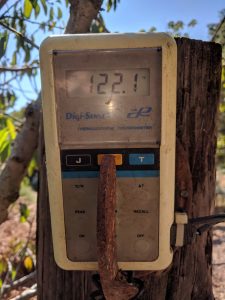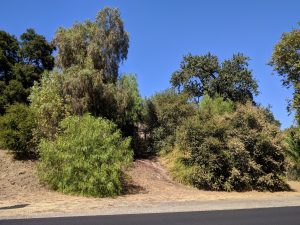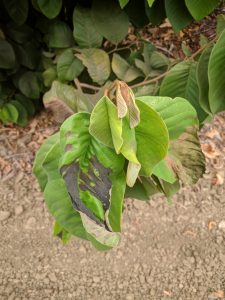Extremes

Here in California we had an extreme heat event on September 6, 2020. In my yard temperatures peaked at 120 degrees F. This also happened back in 2018 earlier in the summer where we reached a similar peak temperature. It is not supposed to get to be 120 degrees F. in Ojai. This year new high temperature records were set all over southern California for the month of September. Following these heat extremes, wildfires have spread from border to border (Canada to Mexico) in western states. As we suffer through heat and flames here in Western US states, we are also now told that this is a la Nina year so Southern California will continue with drought conditions into 2021. Extremes in climate bring hot dry weather to the Western United States and hurricanes and drenching rains to the eastern United States. Plants in landscapes may or may not be adapted to these extremes.

My poster child heat monitor is the coast live oak, Quercus agrifolia. When temperatures exceed triple digits >110F, foliage on this native oak turn brown and burn on the south exposed canopies. They are not adapted to these record temperatures. This can be evidenced by looking at the damage throughout many California communities. Coincidentally other non-native plants are better adapted to high temperatures. The California pepper or Peruvian Pepper (Schinus mole) does fine in 120F weather with no irrigation. Eucalyptus of several species also have tolerated these increased temperatures. Trees that are drought stressed from lack of irrigation after a long dry summer will sunburn more severely than the same plants under consistent irrigation. If you see this kind of damage, its best to leave it alone until the plant responds by growing new shoots.

While study of “climate ready” trees is giving us tree selection options for hotter climates, the research is still new and we have many other species to consider beyond what has been recently reported. Of the species I have in Ventura County few of our study trees showed any damage from the extreme heat, and only the very youngest leaves were damaged on western hackberry and Catalina Cherry. Pistache, Island Oak, Palo Blanco, Tecate cypress, Arizona madrone, and Ghost Gum were not affected by triple digit weather this September. Other ornamental species that were damaged all over Southern California include the following: Avocado, Camphor, Privet, Magnolia, Coast Live Oak, Sycamore (especially the native Platanus racemosa), loquat and ornamental plum.
It our recent heat damage surveys I have observed that Coast Live Oak and Western Sycamore, two native trees that enjoy widespread tree ordinance protections were consistently damaged by our hot day early this month. If we continue to have extreme hot days, poorly adapted native trees will be injured more frequently, and possibly become more susceptible to damaging insects or native pathogens. This tends to restrict the range of natives to areas they are still adapted to growing in or grow into a new region where they are more successful. A time may come when a native tree is not the best choice for your area.
McPherson E.G., Berry, A.M., van Doorn, N.S., Downer, J, Hartin, J., Haver, D., and E. Teach. 2020. Climate-Ready Tree Study: Update for Southern California Communities. Western Arborist 45:12-18.